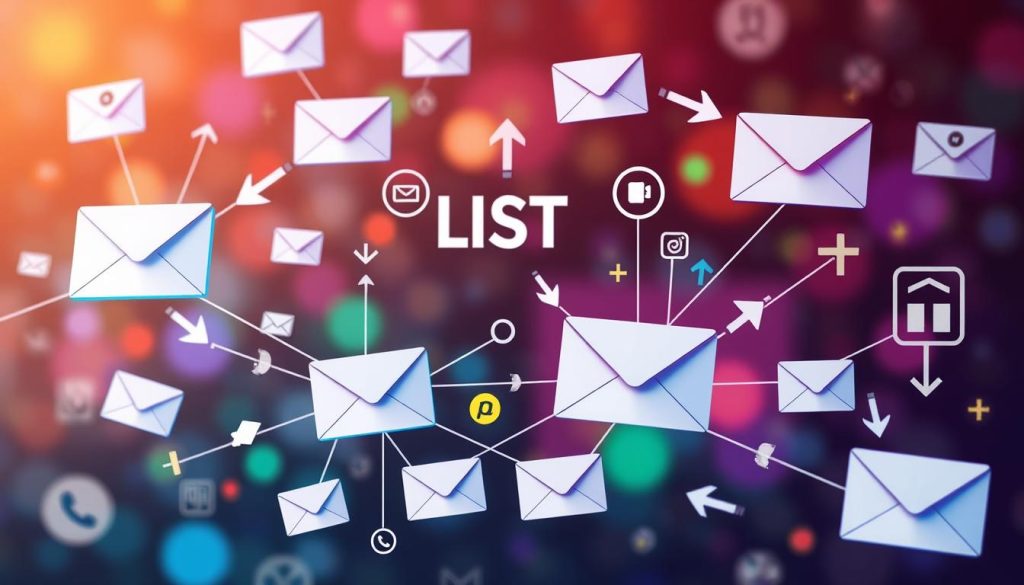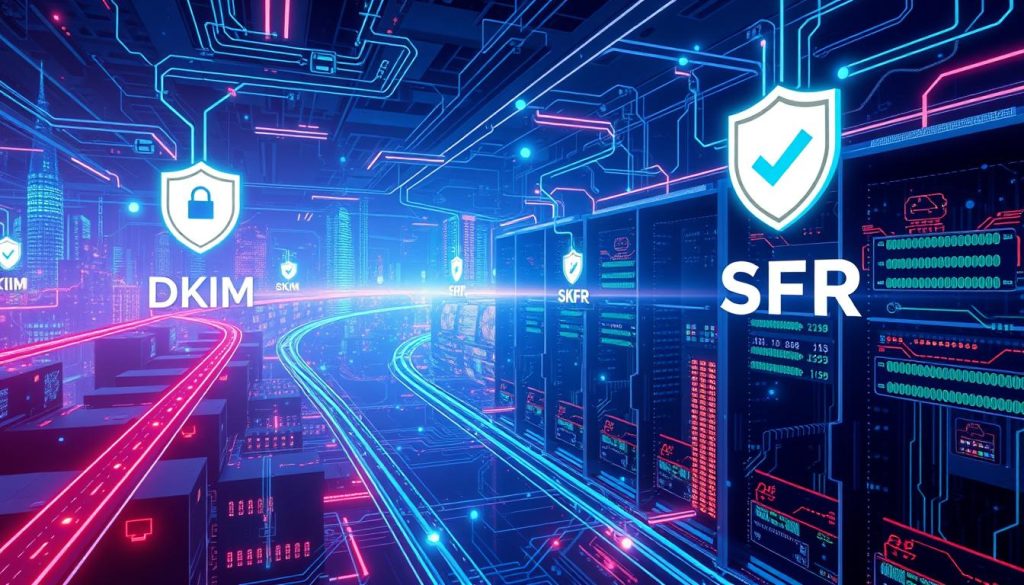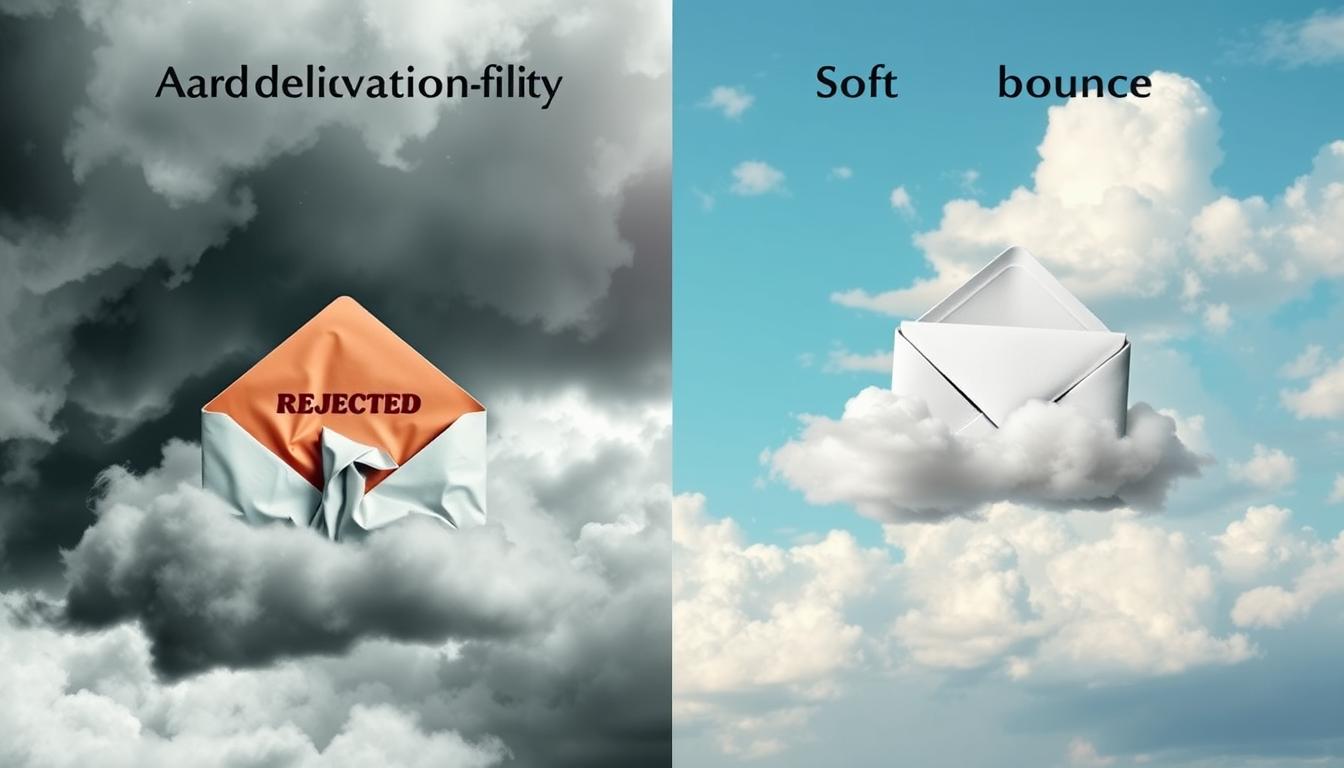Did you know that 31 billion emails bounce every day? While you can’t avoid all email bounces, managing them well is key for cold email success. Knowing the difference between hard and soft bounces is vital for better email delivery and your reputation as a sender. As professional copywriting journalists, we aim to guide you through email bounce complexities and improve your cold emailing tactics.
Key Takeaways
- Hard bounces and soft bounces have distinct causes and consequences for email deliverability.
- Monitoring and understanding bounce rates is essential for successful cold email campaigns.
- Implementing best practices, such as email list hygiene and real-time verification, can help reduce bounce rates.
- Sender reputation and authentication play a crucial role in preventing email bounces.
- Email segmentation and personalization can help avoid spam triggers and maintain high engagement rates.
Introduction to Email Bounces
Email marketing is a powerful tool, but it comes with challenges. One major issue is email bounces. An email bounce happens when an email can’t reach the recipient’s inbox. This affects your email deliverability and bounce rate.
What is an Email Bounce?
An email that can’t be delivered “bounces” back to the sender. There are two main types: hard bounces and soft bounces. Hard bounces are permanent failures, often due to wrong email addresses or non-existent domains. Soft bounces are temporary issues, like a full inbox or a server problem.
The Impact of Bounces on Email Deliverability
High bounce rates, especially hard bounces, hurt your email deliverability. ISPs watch bounce rates to judge a sender’s reputation. A high bounce rate can mark your emails as spam or blacklist your domain, making future emails hard to deliver.
To succeed with cold email outreach, managing your email bounce rate is key. Understanding bounce causes and reducing them can boost your email deliverability. This maximizes your email marketing’s impact.
Understanding Hard Bounces vs. Soft Bounces in Cold Emailing
In cold emailing, knowing the difference between hard and soft bounces is key. A soft bounce happens when an email gets to the server but can’t reach the inbox. This is often due to a full inbox or server problems. On the other hand, a hard bounce means the email can’t be delivered at all. This is usually because the email address is wrong, the domain is inactive, or the server rejects it.
It’s important to understand hard and soft bounces to keep your cold email campaigns working well. Hard bounces need quick action, like removing bad email addresses. Soft bounces, however, can be fixed by solving the temporary issues that stop delivery.
Recent stats show that cold email bounces average at 7.5%. Most of these are soft bounces, with hard bounces being fewer. But, after three failed sends, most email services treat soft bounces as hard ones. This shows why managing bounces well is so important.
Keeping your bounce rate under 4% is best for email campaigns. Using tools like Dropcontact or NeverBounce can help by checking email addresses before sending. This, as seen in tools like QuickMail, can greatly improve how well your emails get delivered by finding and removing bad addresses.
It’s also key to watch for sudden increases in bounce rates, along with the overall rate. Aim for hard bounce rates under 2% and soft bounce rates under 5% in cold email campaigns. High bounce rates can hurt your reputation and make your emails less effective.
Hard Bounces: Causes and Consequences
In the world of cold emailing, hard bounces are a big problem. They happen when emails can’t be delivered because the recipient’s address is wrong or blocked. This can hurt your email’s reputation and make it look like spam.
Common Reasons for Hard Bounces
There are a few main reasons why hard bounces happen in cold email campaigns:
- Invalid or mistyped email addresses: Mistakes in email addresses can cause hard bounces.
- Inactive or closed email accounts: If an email address is no longer used, it will bounce back as hard.
- Domain or server issues: Problems with the email server can also lead to hard bounces.
- Low sender reputation: A bad reputation can make email providers block your messages.
Hard bounces can really hurt your reputation and chances of making sales. It’s important to remove these addresses from your list to keep your emails effective.
| Hard Bounce Errors | Description |
|---|---|
| “Recipient rejected” | The recipient’s email server rejected the message, indicating a permanent delivery failure. |
| “Invalid recipient” | The email address is not valid or does not exist, preventing successful delivery. |
| “No such user” | The email account the message was sent to does not exist, resulting in a hard bounce. |
Knowing why hard bounces happen helps you keep your emails working well. It’s all about keeping your email deliverability and email list hygiene in check. This way, your cold emails can reach their targets effectively.
Soft Bounces: Temporary Setbacks
Hard bounces mean emails can’t reach their destination. But soft bounces are different. They happen when an email gets to the server but can’t get to the inbox. This might be because the inbox is full, the email is too big, or the server is down.
Typical Causes of Soft Bounces
- Full mailbox: The recipient’s inbox is full, stopping new emails.
- Oversized message: The email is too big for the recipient’s server.
- Temporary server issues: The server is having problems, stopping the email.
- Suspected spam: The email is blocked by spam filters, needing more action.
Handling Soft Bounces Effectively
Soft bounces are less serious than hard bounces but still matter. Email services try to deliver soft bounced emails a few times before giving up. By watching soft bounces and fixing the problems, you can keep your email list healthy.
To deal with soft bounces well, follow these tips:
- Keep an eye on your soft bounce rates and figure out why they happen.
- Make sure your email list is clean and up-to-date to reduce soft bounces.
- Use double opt-in to send emails only to people who really want them.
- Make your emails smaller and better to avoid size-related soft bounces.
- Stay out of spam filters by following email best practices.
By tackling soft bounces and managing your email list well, you can send more successful emails. This will help your cold outreach campaigns do better.
Calculating and Monitoring Bounce Rates
Bounce rates are key in cold emailing. They affect how well your emails get delivered and how successful your campaigns are. By keeping an eye on your bounce rates, you can clean up your email list and boost your delivery success.
To find your bounce rate, divide the bounced emails by the total sent. Then, multiply by 100 to get the percentage. A good rate is usually 2% or less. But, it can change based on your email type and list quality.
It’s crucial to watch your bounce rates closely. This helps keep your emails delivered well and your sender reputation strong. By tracking bounce rates over time, you can spot trends and adjust your strategy as needed.
Using charts or graphs to show your bounce rate data can be helpful. It makes it easier for you and your clients to see how your emails are doing and how changes affect them.
Understanding Soft Bounces vs. Hard Bounces
It’s important to know the difference between soft and hard bounces. Soft bounces are temporary, like a full inbox or a server issue. Hard bounces mean a big problem, like an invalid email address.
| Bounce Type | Description | Typical Causes |
|---|---|---|
| Soft Bounce | Temporary delivery failure |
|
| Hard Bounce | Permanent delivery failure |
|
Knowing the difference between soft and hard bounces helps you tackle each issue. This can improve your email delivery success.
Keeping an eye on both soft and hard bounce rates is vital. It helps keep your email list healthy and boosts your cold emailing success. By focusing on this key metric, you can make sure your emails reach the right people and get better engagement.
Strategies to Reduce Bounce Rates
Building a permission-based email list is key to lowering bounce rates in your cold email campaigns. When people opt-in to your emails, you know you’re reaching real, interested people. Using a double opt-in process makes sure your list is clean and boosts your email delivery.
Build a Permission-Based Email List
It’s best to grow your email list naturally, not by buying or renting contacts. This method keeps your list healthy and reduces bounce rates. It also meets the standards of email service providers, who value engaged, opted-in subscribers.
Implement Double Opt-In
Double opt-in improves your email list quality and lowers bounce rates. It requires new subscribers to confirm their interest via a link in a confirmation email. This ensures only real, interested people are on your list. It’s a simple step that greatly improves your email deliverability and campaign success.
| Metric | Benchmark | Implication |
|---|---|---|
| Bounce Rate | Less than 2% | Indicates efficient email delivery |
| Bounce Rate | 2-4% | Suggests attention is needed to improve email practices |
| Bounce Rate | 5% or higher | Signifies a significant problem that requires immediate action |
By focusing on building a permission-based email list and using double opt-in, you can lower bounce rates. This improves your email list building and overall email deliverability.

Email List Hygiene: Best Practices
Keeping your email list clean is key for good email marketing. It’s important to do email list cleaning and real-time email verification often. These steps help your emails get delivered and keep your reputation good.
Regular Email List Cleaning
Check and clean your email list often to get rid of bad addresses. This keeps your bounce rates down and makes sure your emails reach the right people. Clean your list yearly and check your open rates and unsubscribes every quarter.
Real-Time Email Verification
Use real-time email verification for new subscribers. It checks if email addresses are good before adding them. This keeps your list clean and boosts your email success.
A clean email list is the base of a great email marketing plan. Clean your list often and verify new emails in real-time. This keeps your bounce rates low, protects your reputation, and sends your messages to the right people.
Sender Reputation and Authentication
In the world of cold emailing, having a good sender reputation is key. It helps lower bounce rates and ensures your emails get delivered. Important for this is using strong email authentication like DomainKeys Identified Mail (DKIM) and Sender Policy Framework (SPF).
The Importance of DKIM and SPF Records
DKIM and SPF records prove your domain is real. They help avoid your emails being seen as spam or blocked. These steps show email servers your messages come from a trusted place, boosting your delivery rates.
DKIM adds a digital signature to your emails, proving they’re from a real domain. SPF lets domain owners say who can send emails for them.
Using DKIM and SPF makes your sender reputation stronger. This means your cold emails are more likely to be seen and acted upon, leading to better results.

“Maintaining a positive sender history with low complaint rates and robust engagement is key to enhancing your sender reputation and ensuring the successful delivery of your cold emails.”
Other things also help your sender reputation. These include following email rules, keeping your email list clean, and personalizing your emails. By doing these things, you can make your cold emailing more effective.
Email Segmentation and Personalization
To lower bounce rates and boost email delivery, we need to segment our email lists and personalize our campaigns. Targeting specific groups with content they care about makes our emails more relevant and engaging. This reduces the chance of them being seen as spam or ignored.
Avoid Spam Triggers and Monitor Engagement
It’s also key to watch our emails for spam triggers and keep our subscribers engaged. Staying away from spammy language and attachments helps our emails land in the right inbox. Also, tracking open rates, clicks, and unsubscribes helps us spot and fix any issues that hurt delivery.
By using email segmentation and personalization wisely, and keeping an eye on spam and engagement, we can cut down on bounce rates. This makes our cold email campaigns more successful.
FAQ
What is a hard bounce?
A hard bounce means an email can’t be delivered because the address is wrong or doesn’t exist. It’s like sending a letter to a mailbox that doesn’t exist. To keep your email campaigns working, you need to remove these bad addresses right away.
What is a soft bounce?
A soft bounce happens when an email gets to the server but can’t get to the inbox. This might be because the inbox is full or the email is too big. Soft bounces aren’t as bad as hard bounces, but they can still hurt your email success.
How can high bounce rates impact email deliverability?
High bounce rates can hurt your email’s reputation. Sending lots of emails with a lot of bounces can make it harder to get your emails delivered in the future. But, if you send emails carefully, you can avoid this problem.
How can I calculate my email bounce rate?
To find your bounce rate, divide the number of bounces by the total emails sent. Then, multiply by 100 to get a percentage. Aim for a bounce rate of 2% or less for best results.
What are the benefits of building a permission-based email list?
Having a list where people have chosen to get your emails is key to avoiding bounces. Use a double opt-in to make sure only people who really want to hear from you are on your list.
How can email list hygiene help reduce bounce rates?
Keeping your email list clean is important to avoid bounces. Remove any bad or inactive addresses. Using real-time checks can help catch problems before they cause bounces.
How can email authentication protocols like DKIM and SPF help with bounce rates?
Having a good sender reputation is vital for avoiding bounces. Using DKIM and SPF helps prove your emails are real. This makes it less likely for your emails to be seen as spam.
How can email segmentation and personalization help reduce bounce rates?
Segmenting your list and personalizing your emails can make them more relevant. This means your emails are more likely to be opened and read, not ignored or marked as spam.
Source Links
- The Difference Between Hard Bounces and Soft Bounces in Email – Plus 9 Ways to Reduce Them
- Soft bounce vs hard bounce: the difference in cold emailing
- Inframail – World’s First Email Setup Platform
- Hard Bounce Vs Soft Bounce Email: What You Need To Know Before Buying? – ColdICP
- Email Bounce: How To Fix Email Bounce Back Effectively?
- The Definitive Guide To Prevent Email Bounce | QuickMail
- Understanding Email Bounces In Cold Email Outreach – Mystrika – Cold Email Software
- The Complete Guide to Email Bouncebacks in 2023 – Mystrika – Cold Email Software
- What is Domain Email Reputation? Steps to Check & Improve
- What’s Soft Bounce VS Hard Bounce and how can you fix it ?
- Master Cold Email Outreach Like a Pro: The Definitive Guide to Crushing Bounce Rates
- Understanding email bounces – soft vs hard bounces
- What Are Good Conversion Metrics for Cold Emails?
- Bounce Back Emails: 7 Ways To Reduce Your Email Bounce Rate
- Email Bounce Rate – KPI Definition, Formula & Tips – AgencyAnalytics
- 9 Key Strategies to Reduce Email Bounces in Cold Outreach
- Effective Strategies to Reduce Email Bounce Rate
- The Ultimate Guide to Email Bounce Rates (And How to Reduce!)
- The Ultimate Guide to Reducing Email Bounce Rates
- Email List Hygiene Best Practices – Octopus CRM
- Email Hygiene | Email List Hygiene
- How Does Sender Reputation Affect Email Deliverability?
- Prevent your emails from bouncing (email bounce rate)
- Decoding the Difference: Hard Bounce vs. Soft Bounce in Cold Outreach Email Marketing
- Understanding Soft Bounce vs Hard Bounce Email
- Hard Bounce vs. Soft Bounce Emails: What’s the Difference?


